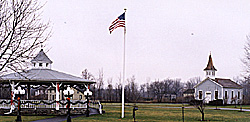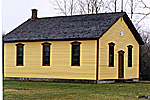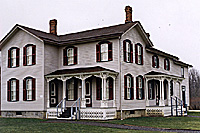 The real treat of the Amherst Museum is the collection of ten 19th century houses (two others are replicas). These were taken from various parts of the town and moved to the 35-acre museum grounds, where they underwent restoration. Some are available for self-guided tours, while the interiors of others are only accessible with a guided tour. The houses are closed in cold weather.
The real treat of the Amherst Museum is the collection of ten 19th century houses (two others are replicas). These were taken from various parts of the town and moved to the 35-acre museum grounds, where they underwent restoration. Some are available for self-guided tours, while the interiors of others are only accessible with a guided tour. The houses are closed in cold weather.
As you exit the Shaw building, you come to the "Town Green" with the gazebo front and center. Off to the right is building number 12, Transit Road Church (circa 1854). These are shown in the photo at right.
A path meanders throughout the park in roughly a clockwise direction.
 The houses are:
The houses are:
- Lavocat House (1840) Built using the nogging construction technique using layers of brick between wood frames.
- Williamsville School #9 (1880) One room yellow schoolhouse in use until 1950s, when it was then used as a youth center before being moved to the museum. Victorian Italiante style. Photo at right.
- Blacksmith Shop (replica)
-
 Garrison Road House (1851) Built for George W. Elliot, ploughmaker. Sold to his creditors 1855.
Garrison Road House (1851) Built for George W. Elliot, ploughmaker. Sold to his creditors 1855.
- Barbershop (1898)
- Sweet Home Common School #15 (1847) Built at a cost of $125, the school closed in 1948.
- Hoover House (1850) Victorian Italiante architecture built on a farm owned by George Hoover, the house was enlarged several times. The look now is circa 1880. Photo at right.
-
Smith Log House (1838) Originally in the "French Settlement," it was built by Henry Smith (Schmitt), who had come from Alsace-Lorraine.
 The Smith family consisted of Henry, his wife, six kids, and his mother-in-law. Photo at right.
The Smith family consisted of Henry, his wife, six kids, and his mother-in-law. Photo at right.
- Neumann Pioneer Chapel (replica)
- Dann Road House (1850) Plank house typical of early cottage farmhouses lived in by tenant farmers or farm hands.
- Bigelow Salt Box House (1840) Style derived from boxes used by colonists to keep their salt dry. Bigelow came from New Hampshire. The south section was built between 1838-1845, the north between 1845-1855.
- Transit Road Church (1854) Founded by Trinity Evangelical Lutheran Church, German immigrants who wished to practice their religion using German language. All stained glass (except rear window) is original.
Source: Self Guided Tour pamphlet, Amherst Museum, Amherst NY.
More Amherst Museum
-
Introduction to the Museum
History of the Museum
Shaw and Steffen Buildings
Historic House Park
1998 Event Calendar
Museum Contact Information, Hours, and Directions
Back to List of Historical Sites
Back to Travel Master List
Back to MagWeb Master List of Magazines
© Copyright 1997 by Coalition Web, Inc.
This article appears in MagWeb (Magazine Web) on the Internet World Wide Web.
Other military history articles and gaming articles are available at http://www.magweb.com